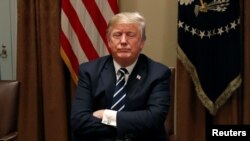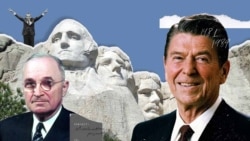It was a week of bewilderment over what President Donald Trump really thinks about Russian interference in the U.S. election and what he and Russia’s Vladimir Putin told each other in their private meeting. The confusion was fed by Trump’s vacillating statements about the summit.
On other fronts, Trump inaccurately claimed Queen Elizabeth II bestowed upon him an honor that she had never before granted during her reign and, when the president was back in the U.S., he gave a faulty account of improvements in health care for veterans.
A week in review:
TRUMP: “The Summit with Russia was a great success, except with the real enemy of the people, the Fake News Media. I look forward to our second meeting so that we can start implementing some of the many things discussed, including stopping terrorism, security for Israel, nuclear ... proliferation, cyber attacks, trade, Ukraine, Middle East peace, North Korea and more. There are many answers, some easy and some hard, to these problems ... but they can ALL be solved!” — tweets Thursday.
THE FACTS: Trump implies that he reached broad agreements with Putin during the Helsinki meeting that the two countries “can start implementing” with a second meeting. If he did, his own White House and State Department seem not to know about it.
White House press secretary Sarah Sanders mentioned humanitarian aid for Syria, Iran, Israel, arms control, Russia’s annexation of Crimea from Ukraine and its meddling in 2016 U.S. election as having been discussed. When pressed for details on any planned action, she could not provide any.
“This is the beginning of the dialogue with Russia and our administration and theirs and we’re going to continue working through those things,” Sanders told reporters Wednesday.
The State Department offered its own take on the Helsinki meeting, saying no agreements were reached and that there were just general proposals on matters mainly related to economic and strategic cooperation.
TRUMP, addressing whether Russia was interfering in the 2016 election: “The whole concept of that came up perhaps a little bit before, but it came out as a reason why the Democrats lost an election — which, frankly, they should have been able to win, because the Electoral College is much more advantageous for Democrats, as you know, than it is to Republicans. We won the Electoral College by a lot — 306 to 223, I believe.” — remarks Monday.
THE FACTS: Trump makes the misguided assertion, again, that Democrats have an “advantage” in the Electoral College. Its unique system of electing presidents is actually a big reason why Trump won the presidency. Four candidates in history have won a majority of the popular vote only to be denied the presidency by the Electoral College. All were Democrats.
In the 2016 election, Democrat Hillary Clinton received nearly 2.9 million more votes than Trump after racking up more lopsided victories in big states such as New York and California, according to election data compiled by The Associated Press. But she lost the presidency because of Trump’s winning margin in the Electoral College, which came after he narrowly won less populous Midwestern states, including Michigan and Wisconsin.
Unlike the popular vote, Electoral College votes are set equal to the number of U.S. representatives in each state plus its two senators. That means more weight is given to a single vote in a small state than the vote of someone in a large state.
Trump also misstates the Electoral College vote. The official count was 304 to 227, according to an AP tally of the electoral votes in every state.
TRUMP: “I want to have choice, just like we have now with the veterans, all approved, which nobody thought would be possible. The vets now, instead of standing on line for two weeks or one week or three months, they can go out and see a doctor, and we pay for it, and it turns out to be much less expensive. And they are loving it.” — remarks Wednesday at Cabinet meeting.
THE FACTS: The Department of Veterans Affairs’ Choice program for veterans that Trump refers to is not “all approved.” Nor are veterans necessarily loving the private-sector health care program, as measured by the average amount of time veterans must wait for a medical appointment with a private doctor. Trump’s suggestion that veterans are getting immediate care because of Choice does not reflect the reality.
Trump did sign into law last month a bill that would ease restrictions on private care. But its success in significantly reducing wait times depends in large part on an overhaul of VA’s electronic medical records to allow for a seamless sharing of records with private physicians. That overhaul will take at least 10 years to be complete.
Under the newly expanded Choice program that will take at least a year to implement, veterans will still have to meet certain criteria before they can see a private physician. Those criteria will be set in part by proposed federal regulations that will be subject to public review.
Currently, only veterans who endure waits of at least 30 days for an appointment at a VA facility are eligible to receive care from private doctors at government expense. A recent Government Accountability Report found that despite the Choice program’s guarantee of providing an appointment within 30 days, veterans waited an average of 51 days to 64 days.
TRUMP: “We met with the Queen, who is absolutely a terrific person, where she reviewed her Honor Guard for the first time in 70 years, they tell me. We walked in front of the Honor Guard, and that was very inspiring to see and be with her.” — remarks Tuesday during a meeting with members of Congress.
THE FACTS: No, Queen Elizabeth II did not review her Honor Guard for the first time in 70 years when Trump visited last week. She’s only been on the throne for 66 years.
The queen regularly inspects her Honor Guard as part of royal duties, often during visits from foreign officials. That included when President Barack Obama visited in 2011.
TRUMP, when asked Wednesday during a Cabinet meeting if Russia was still targeting U.S. elections: “No.”
THE FACTS: Trump’s apparent response that Russia does not pose a risk to future U.S. elections contradicted the warning from his director of national intelligence, Dan Coats, days earlier on the threat of Russian interference in the 2018 elections. Coats compared the cyberthreat today to the way U.S. officials described before 9/11 the risk of a terrorist attack as indicated from intelligence channels: “Blinking red,” with warning signs of an imminent attack.
Sanders said later Wednesday that Trump actually was saying “no” to answering additional questions — even though he subsequently went on to address Russia.
TRUMP, on his intelligence officials on Monday: “They said they think it’s Russia. I have President Putin. He just said it’s not Russia. I will say this — I don’t see any reason why it would be.”
TRUMP, reading from a statement, on his intelligence officials on Tuesday: “I accept our intelligence community conclusion that Russia meddling ... took place” and the “sentence should have been 'I don’t see any reason why it wouldn’t be Russia.' ”
TRUMP, when asked by CBS on Wednesday if he agreed that Russia meddled in the 2016 election: “I have said that numerous times before, and I would say that is true, yeah.”
THE FACTS: Was Trump’s comment Monday a misunderstanding set off by his saying “would” instead of “wouldn’t”? Or was his rare admission of a mistake rooted in the ferocity of the stateside response by those — Republicans among them — who said he'd undermined U.S. intelligence services by seeming to side with Putin?
Whichever the case, Trump at various points in his Monday news conference made clear that he found Putin’s position on the matter compelling.
“I will tell you that President Putin was extremely strong and powerful in his denial today,” Trump said at the joint news conference. He made the untenable assertion Monday that “I have confidence in both parties” — his intelligence officials, who say Moscow interfered, and Putin, who says it didn’t.
Trump has been a nearly solitary figure in his administration in holding on to doubts about whether Russians tried to sway the election. Trump’s top national security officials, Democrats and most Republicans in Congress say U.S. intelligence agencies got it right in finding that Russians secretly tried to sway the election. The special counsel’s continuing Russia investigation has laid out a detailed trail of attempts and successes by Russians to steal Democratic Party and Clinton campaign communications and to leak embarrassing emails and documents.
Putin denied anew that the Russian government interfered, but he acknowledged Monday that he favored Trump in 2016. “Yes, I wanted him to win because he spoke of normalization of Russian-U.S. ties.”
PUTIN, referring Monday to Bill Browder, a prominent Putin critic and investor charged with financial crimes in Russia: “Business associates of Mr. Browder have earned over $1.5 billion in Russia. They never paid any taxes, neither in Russia nor in the United States, and yet the money escaped the country. They were transferred to the United States. They sent a huge amount of money, $400 million, as a contribution to the campaign of Hillary Clinton.”
THE FACTS: The notion of a $400 million donation to the Democrat’s campaign is a stratospheric exaggeration. On Tuesday, the Russian general prosecutor’s office said, to little fanfare, that Putin misspoke and meant $400,000.
The Clinton campaign committee raised less than $564 million. With supportive political action committees added to the equation, Clinton’s effort drew $795 million in donations. Putin’s initial figure suggested a huge chunk of her money came from a small cabal of financiers.
The reality is much less dramatic.
Browder’s New York financial partners, Ziff Brothers Investments, donated only $1.75 million in the 2016 campaign, spreading it among candidates for many offices in both parties and favoring Republicans in congressional races. The watchdog site opensecrets.org shows it giving only $17,700 for Clinton’s election and less than $300,000 to the Democratic National Committee, as well as smaller amounts to other entities.
Donations to Clinton came from diverse sources: the financial industry, education interests, Hollywood, unions, the health and pharmaceutical sectors, and many more.
TRUMP, on increased military spending by NATO countries: “I had a great meeting with NATO. They have paid $33 Billion more and will pay hundreds of Billions of Dollars more in the future, only because of me. NATO was weak, but now it is strong again (bad for Russia)." — tweet Tuesday.
THE FACTS: No, increased military spending by NATO members is not “only because” of him. The broader move toward rising spending by NATO countries began under Obama.
NATO members agreed in 2014 to stop cutting their military budgets and set a goal of moving “toward” spending 2 percent of their gross domestic product on their own defense by 2024. Most NATO members are spending less than 2 percent, though more are moving in that direction. The issue is not one of payments to NATO, as Trump repeatedly puts it, but how much members spend on their own armed forces.
After being prodded by Trump to give him credit, NATO Secretary-General Jens Stoltenberg indicated that Trump’s big demands had some effect on the military spending. He estimated European allies and Canada would add $266 billion to their military spending by 2024 and said of Trump, “This is really adding some extra momentum.” By one NATO estimate, alliance members apart from the U.S. collectively increased their military budgets by $33 billion last year.


























